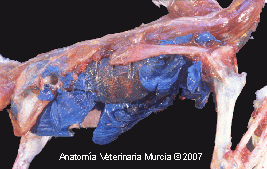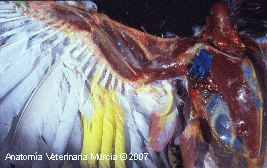The Respiratory System:
The respiratory system is specifically adapted for flight. This activity requires
a high level of muscular activity, consuming increased amounts of oxygen and
this requires rapid, efficient and powerful ventilation. The nares
open from the dorsal rhamphotheca of the beak,
either on the keratinized plate or on the
sensitive cere. The colour of the cere can be used to know if a bird is well-nourished
(raptors), or to identify sex (budgerigars: blue in the cock and brown in
hen and young birds). The nasal cavities are separated by the medial nasal
septum, which can be incomplete rostrally (web-footed). There are three nasal
conchae (rostral, middle and caudal), while the ethmoidal concha isn’t
developed, due to the poor development of the olfactory sense.
The infraorbital sinus is a cavity in the lateral wall of the nasal cavity,
ventral and caudal to the eye. It communicates with the caudal nasal concha
and nasal cavity.
In many parrots the left and right infraorbital
sinuses communicate with each other and have expansions (diverticula), which
pneumatize extensive areas of the skull. In some species, like the Amazonian
Parrot, these diverticula extend dorsolaterally on each side of the neck as
far caudally as the seventh cervical vertebra.
The inspired air passes from the nasal cavities to the oropharynx via the
median slit-like opening in the palate, the choana, and then into the larynx,
which is formed by the cricoid and arytenoid cartilages (the epiglottis doesn't
exist).
Birds have no vocal cords and the laryngeal
muscles are rudimentary. This is due to the fact that the larynx, unlike in
mammals, does not play a part in the production of sounds (phonation).
The trachea consists of 100 to 130 cartilaginous rings which generally ossify.
These rings are also found in the main bronchi.
In long necked species (swans and cranes), the trachea is massively elongated forming coils that lie in the excavation of the sternum. This hypertrophy appears to be related with an increase in the strength of the voice. The bifurcation of the trachea is modified to form the sound production organ of the bird: the syrinx or caudal larynx,
which can be absent in some species (vulture,
ostrich, stork). Strong syringeal muscles tense two pairs of vibrating membranes.
Quality and variation of the sounds depends on the function of those muscles.
The primary bronchi enters the parenchyma of the lungs,
which only represent 11% of the respiratory system, but have a great functional capacity. Both principal bronchi expand forming vestibules and continue as mesobronchus to the caudal end of the lung, where they open into the abdominal air sacs. The middle bronchi opens to the thoracic caudal air sac. Air sacs are extrapulmonary membranous expansions, that lie between the viscera and walls of the body cavity.
 |
 |
 |